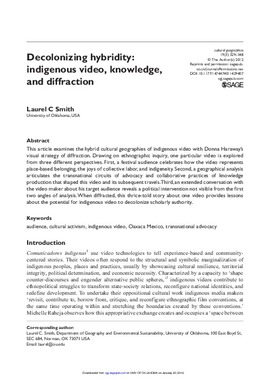| dc.contributor.author | Laurel C Smith | |
| dc.date.accessioned | 2016-01-14T19:53:40Z | |
| dc.date.accessioned | 2016-03-30T15:32:04Z | |
| dc.date.available | 2016-01-14T19:53:40Z | |
| dc.date.available | 2016-03-30T15:32:04Z | |
| dc.date.issued | 2012-07-01 | |
| dc.identifier.citation | Smith, L. C. (2012). Decolonizing hybridity: indigenous video, knowledge, and diffraction. Cultural Geographies, 19(3), 329-348. doi: 10.1177/1474474011429407 | en_US |
| dc.identifier.uri | https://hdl.handle.net/11244/25384 | |
| dc.description.abstract | This article examines the hybrid cultural geographies of indigenous video with Donna Haraway’s visual strategy of diffraction. Drawing on ethnographic inquiry, one particular video is explored from three different perspectives. First, a festival audience celebrates how the video represents place-based belonging, the joys of collective labor, and indigeneity. Second, a geographical analysis articulates the transnational circuits of advocacy and collaborative practices of knowledge production that shaped this video and its subsequent travels. Third, an extended conversation with the video maker about his target audience reveals a political intervention not visible from the first two angles of analysis. When diffracted, this thrice-told story about one video provides lessons about the potential for indigenous video to decolonize scholarly authority. | en_US |
| dc.language.iso | en_US | en_US |
| dc.publisher | Cultural Geographies | |
| dc.subject | audience | en_US |
| dc.subject | cultural activism | en_US |
| dc.subject | indigenous video | en_US |
| dc.subject | Oaxaca Mexico | en_US |
| dc.subject | transnational advocacy | en_US |
| dc.title | Decolonizing hybridity: indigenous video, knowledge, and diffraction | en_US |
| dc.type | Research Article | en_US |
| dc.description.peerreview | Yes | en_US |
| dc.description.peerreviewnotes | https://us.sagepub.com/en-us/nam/manuscript-submission-guidelines | en_US |
| dc.identifier.doi | 10.1177/1474474011429407 | en_US |
| dc.rights.requestable | false | en_US |
